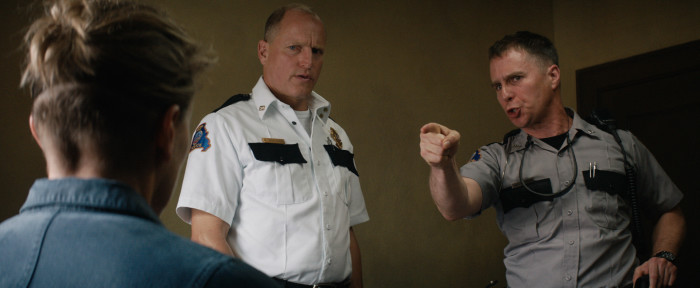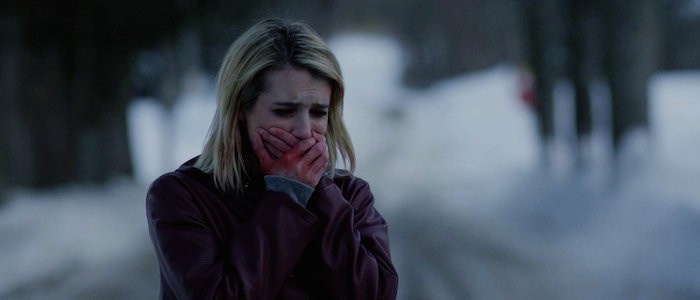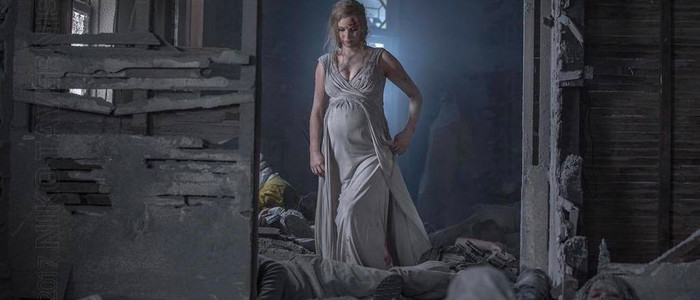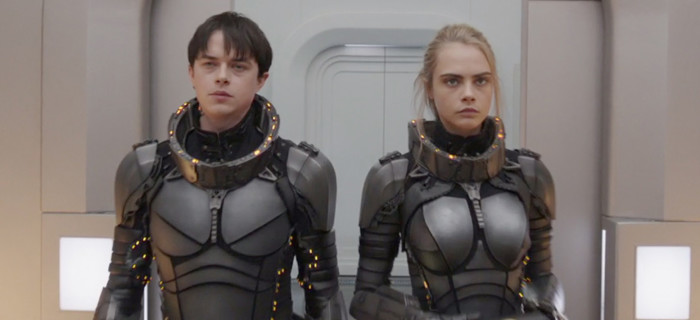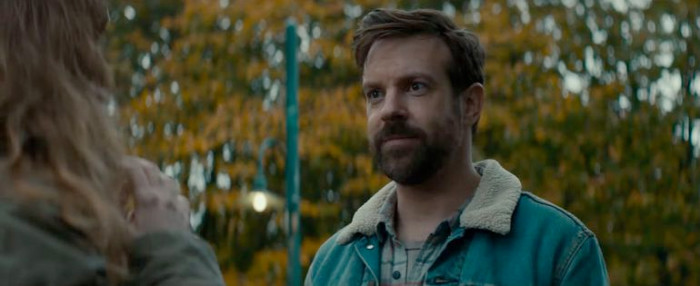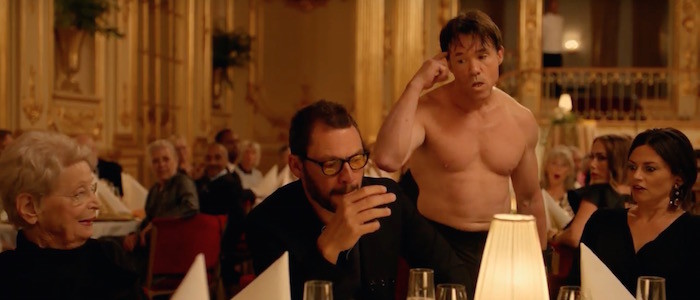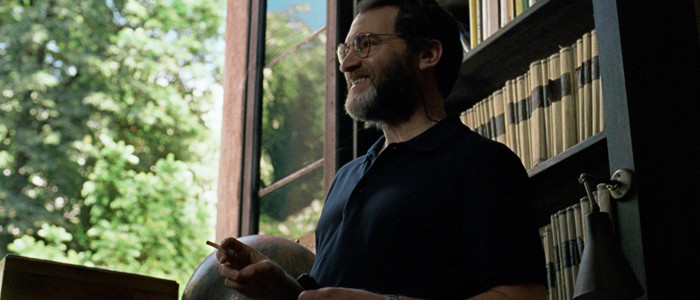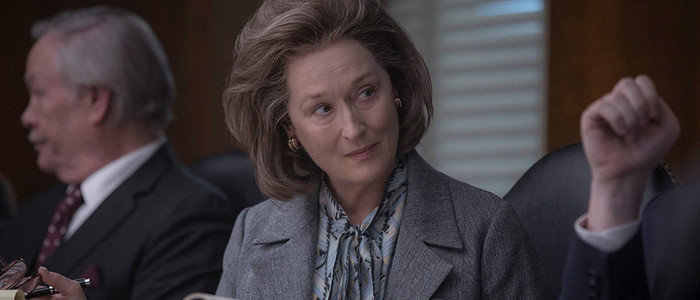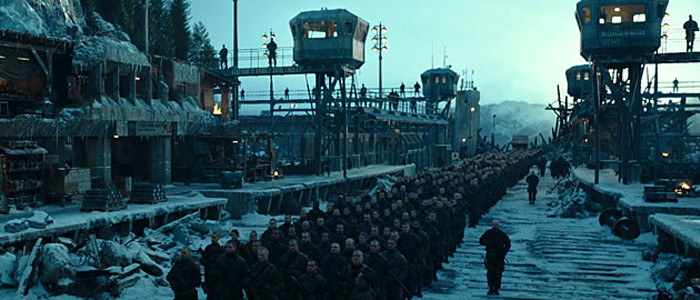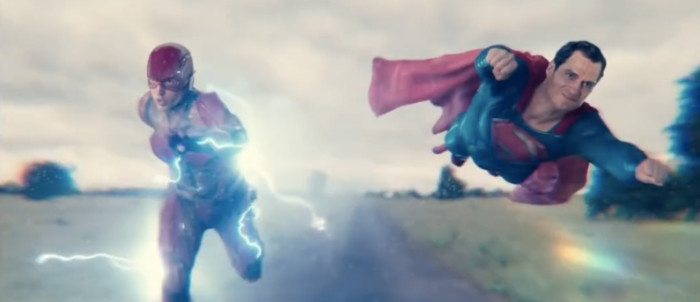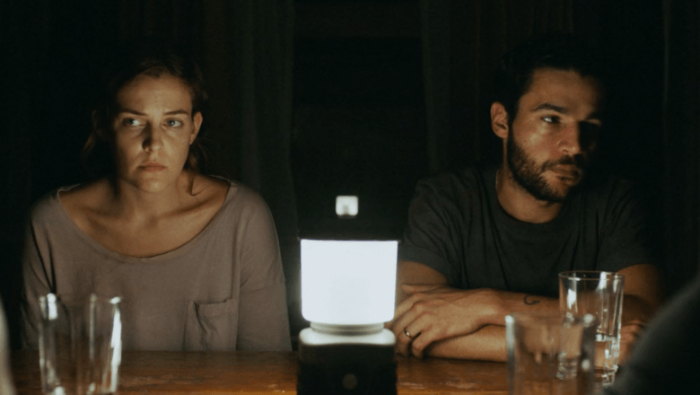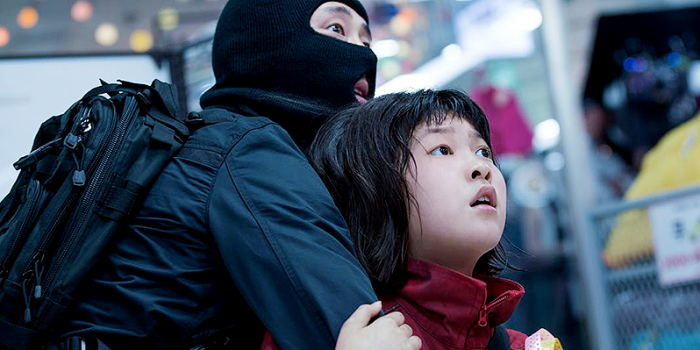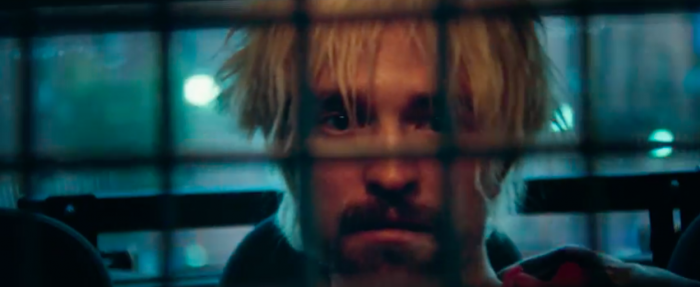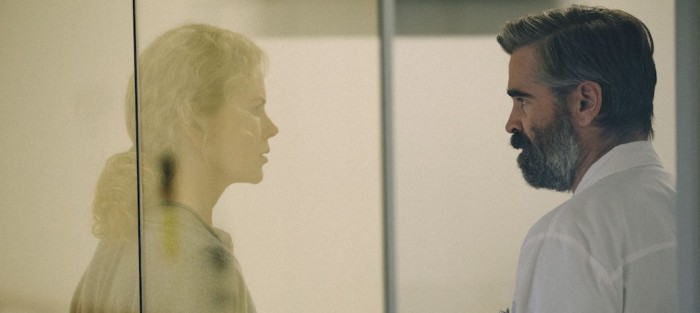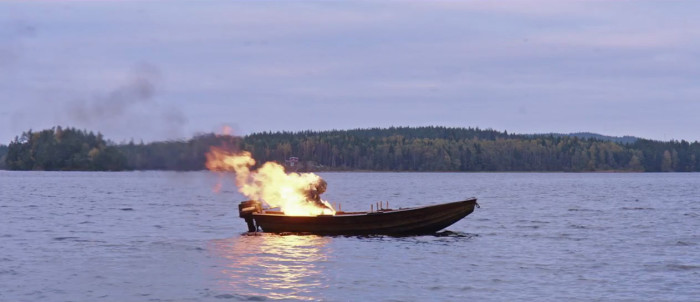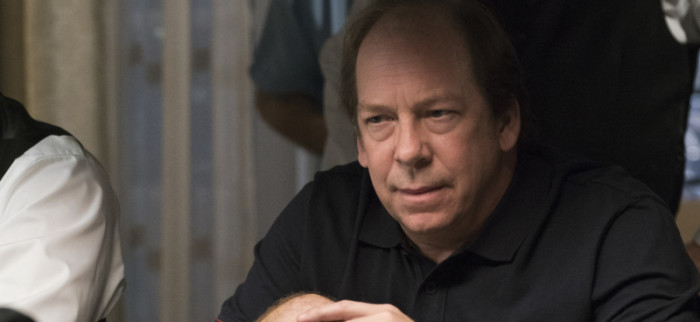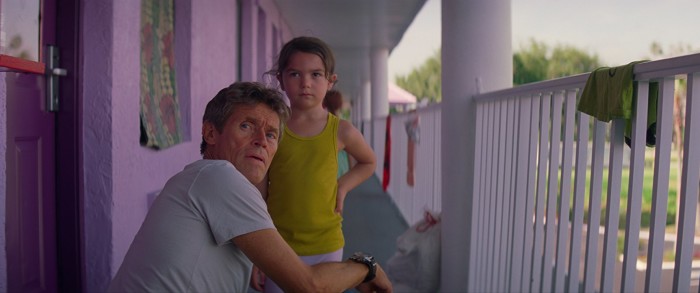56 Movie Moments We Loved In 2017
The /Film team sat down to make a list of the 50 best movie moments of 2017. We ended up with a list of the 56 best movie moments of 2017 because the year was just that great.
These are the moments, the scenes, the sequences, the lines of dialogue, the lingering glances, the jokes, the reaction shots, the grand gestures, the spellbinding action beats, and the tiny kernels of humanity that stand out for us. As we look back on cinema in 2017, these moments linger in our minds, reminding us why we love movies so damn much in the first place.
Join us, won't you?
If you're in more of a listening mood, we discussed the highlights of this list on the latest episode of /Film Daily and you can check it out via the embed below:
Willoughby Sneezes in Three Billboards Outside Ebbing, Missouri
Mildred (Frances McDormand) and Sheriff Willoughby (Woody Harrelson) have every reason to hate each other's guts. He failed to find the man who raped and murdered her daughter. She's gone and paid for three billboards that publicly call out local law enforcement for not doing their job. They're both angry, witty, endlessly patient people and their big meeting in the police station's interrogation room is an exchange of entertaining barbs, two talented talkers and quick thinkers looking to get the better of the other, to win the squabble. But then Willoughby sneezes. And within that sneeze is a cloud of blood, which paints Mildred's face. Because he is dying of cancer. In an instant, this cocky charmer is shamed, reduced to apologizing profusely to the woman he wanted to break. In an instant, Mildred forgets about her vendetta and rushes to get help. In an instant, these two adversaries become, well, people. People who ultimately care about each other. And in this dark, dreary, and blackly humorous world created by writer/director Martin McDonagh, reclaiming your empathy from a pit of despair is the first step (or is it a stumble?) toward grace. Or something like it. (Jacob Hall)
Diana Enters No Man’s Land in Wonder Woman
Every superhero has their moment of "becoming." The decision they make to rise above their station, to embrace their responsibility to wield their extraordinary power for good. No Man's Land in Wonder Woman was that moment for Diana. The scene itself is relatively simple: Diana merely storms across No Man's Land, drawing gunfire and leading the charge toward the village that had been taken by German soldiers. There's no triumphant yell of "I'm Wonder Woman!" — in fact, her superhero nom de plume is never spoken once. But when Diana ignores Steve Trevor's frenzied insistence that she "can't save everyone," shedding the restrictive clothes that hide her true identity, no words need to be spoken. As Diana slowly makes her way across the stretch of land separating the Allied troops and the German troops, deflecting bullets with her bracelets, this was the moment where she realizes who she truly is. "It is the birth of Wonder Woman," director Patty Jenkins said of the scene, which was famously nearly cut from the film. Gal Gadot gives a winning performance as Diana during the scene, her face transforming from bullish conviction, to nervous uncertainty, and finally to unflagging determination.
And there are levels to this scene. First, it's monumental to see a that empowered moment of "becoming" for a female superhero on the big screen — something we've rarely seen unless it's oozing with vampy sensuality (Michelle Pfeiffer's Catwoman in Batman Returns) or deep, dark trauma (Jennifer Garner in Elektra). There's the added nuance that Diana is rebuffing the rules of the patriarchy, of a man literally telling her that it cannot be done, by throwing off her impractical outfit made to restrict women. And then there's the particularly on-the-nose title of the scene: "No Man's Land."
But there's an added importance to this scene: it's the first where Diana embodies Wonder Woman's ability to inspire. It may seem like a given that once Diana stepped out onto No Man's Land that everyone else would follow, but it's truly a miracle that the soldiers do. Steve and his group of hired hands are the first to follow Diana, but when the other soldiers timidly make their way past the trenches before breaking into a full charge across a stretch of land that they had manned for months, that's the true extent of Wonder Woman's power. It's awe-inspiring, and...a little cheesy? But don't tell that to Jenkins. "Cheesy is one of the words banned in my world," Patty Jenkins told the New York Times ahead of Wonder Woman's release. "I'm tired of sincerity being something we have to be afraid of doing. It's been like that for 20 years, that the entertainment and art world has shied away from sincerity, real sincerity, because they feel they have to wink at the audience because that's what the kids like. We have to do the real stories now." The lack of a core action sequence and the abundance of sincerity may be offputting to some, but there's no room for cynicism in Wonder Woman. (Hoai-Tran Bui)
Deckard Shaw Saves Dom's Baby in The Fate of the Furious
Though it was full of ludicrous (and Ludacris) moments, The Fate of the Furious couldn't quite reach the insane highs of Fast Five or even its direct predecessor, Furious 7. But one of the times it came closest resulted in one of our favorite movie moments of 2017: a scene in which Jason Statham's Deckard Shaw fights off a dozen armed guards on a high-security plane, all while protecting a baby that's strapped into a car seat. It's an homage to John Woo's action classic Hard Boiled in the only way the Fast & Furious franchise knows how: completely over the top. Statham's asides to the baby (who's wearing headphones during the whole thing to muffle the copious gunshots) are pretty close to perfect – there's a particularly fun bit with him wondering whether a foul smell is emanating from the baby's diaper or a guy he just dispatched. Director F. Gary Gray utilized the actor's dry, tough guy delivery to its full comedic effect here, just as Paul Feig's Spy did two years beforehand. (Ben Pearson)
The "Bellbottoms" Chase in Baby Driver
There's a reason the entire six-minute opening heist and chase from Baby Driver was released online to promote the movie, and that's because it sets the stage for the glorious, synchronous action musical that follows from director Edgar Wright. Not only does it illustrate how integral music will be to the rhythm of the film, both in the action and the editing, but it introduces us into the charming character of Baby and his obsession with living his life to the beat of his own iPod. Combine that with the fact that this chase, with perfect practical driving stunts, is one of the most exciting sequences put to film in 2017, and it's clear why this is one of our favorite moments. (Ethan Anderton)
The Silencer Shootout in John Wick: Chapter 2
John Wick: Chapter 2 features some of the most finely staged and unique action scenes to come out of Hollywood in...ever? It is, quite frankly, one of the best action movies ever made. But the film isn't just a parade of shootouts and brawls – the action complements the characters and the rich, often hilariously complex world they inhabit. There is a sense of humor on display here that gives every action beat personality. And that brings us to the best moment in the film: John Wick (the expectedly great Keanu Reeves) returns to New York City and finds himself attacked by assassins on literally every street corner, each of them attempting to claim the bounty on his head. Soon, he encounters the vengeful Cassian (an unexpectedly great Common) and the two engage in a cat-and-mouse chase through a subway station, casually firing silenced pistols at one another as they navigate a crowd of people who don't notice the brutal battle happening in their midst. It's a clever scene and a funny scene and a thrilling scene, the most satisfying moment in a film that seems to be composed entirely of satisfying moments. (Jacob Hall)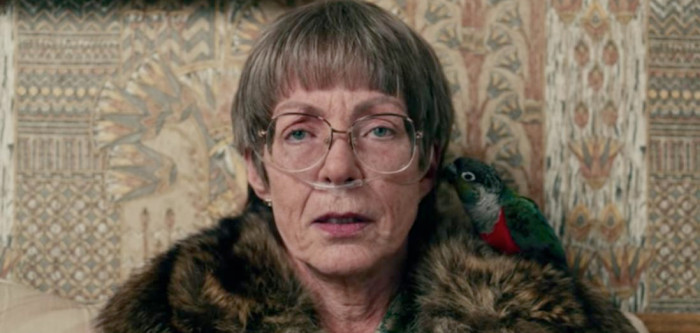
A Confrontation With Mom in I, Tonya
Tonya Harding has already had a difficult enough life, starting with an abusive childhood where her mother (Allison Janney) expected the best from her ice skating, belittling her at every turn, and even throwing a knife at her during her formative teenage years. But when the shit really hits the fan and the press is swarming her house after she's suspected of being involved in the attack on fellow figure skater Nancy Kerrigan, it appears there might be redemption as Tonya's mother comes to comfort her daughter. However, it turns out that this is nothing more than one more betrayal as Tonya discovers that her mother is only there in an effort to get a confession on tape. There's no redemption for Tonya's mother at all. She's a scheming opportunist who doesn't have a good bone in her body. Tonya doesn't have anyone in her corner, and it's heartbreaking. (Ethan Anderton)
Oliver Dances in Call Me By Your Name
For 40 glorious seconds in Call Me By Your Name, Armie Hammer danced badly in dad shorts. And a meme was born.
But Oliver's dorky dancing was more than just a moment of levity in an achingly gorgeous, slow-burning gay love story. This is a scene replete with yearning, with the melancholy of wanting what you can't have. Oliver has been invited to a night out on the town by Elio (Timothée Chalamet) and his friends, and he spends the evening blissfully unaware of the effect that he has on everyone — except for perhaps the local girl Chiara (Victoire Du Bois) with whom he dances seductively and kisses. As this happens, everyone giggles knowingly, except for Elio, who leans forward in his chair, a tumult of emotions crossing over his face. Is he happy? Jealous? Turned on? The brief scene disappears in a few seconds, seeming instead to shift its focus to the raucous night itself as Elio hops onto the dance floor himself. But as fun and near-silly as it is, the ephemeral moment becomes rife with subtext, and a turning point for Elio's grappling with his attraction to Oliver. And hey, who doesn't love watching Armie Hammer dance? (Hoai-Tran Bui)
Rooney Mara Eats a Pie in A Ghost Story
Somehow, Rooney Mara had never eaten a pie before filming A Ghost Story. I don't know how this is possible; maybe wealthy people only eat flan? Either way, the script for A Ghost Story required Mara's grieving widow to eat an entire pie in two very long shots: one where she eats the pie while standing, one while she's slumped on the floor against a cabinet. "The first one, we did two takes of, and she took a couple bites in each one," A Ghost Story director David Lowery said of the scene. "Then she sat down, and that [shot] was one take. We were like, 'Keep going until you can't eat anymore.' The script said she eats the whole thing. I think she had a couple bites left, but we'd tortured her long enough."On one level, the scene is memorable because it's literally us watching Rooney Mara eat (almost) an entire pie. But once you get beyond the somewhat silly nature of such a thing, there's also a sadness to it all. Mara's character has just returned from the funeral of her husband (who now haunts the house decked-out in a bedsheet), and in an attempt to feel something, anything, other than grief, she scarfs down the nearest item of food; it's the very definition of "comfort food." After she's finished, she rushes into the bathroom and vomits it all up. Even the briefest moments of comfort are fleeting in the presence of death. (Chris Evangelista)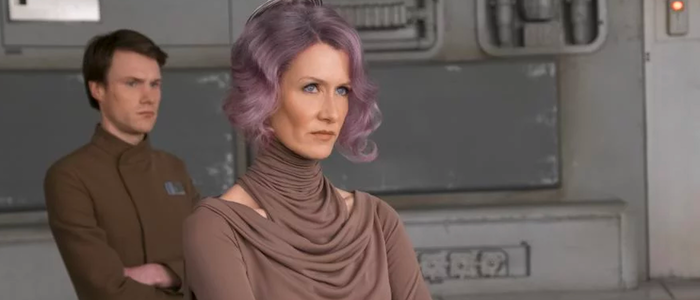
Holdo's Lightspeed Gambit in Star Wars: The Last Jedi
Hate or love The Last Jedi, it did something that we've never seen done in a Star Wars movie before. It provided us with an indelible image, a moment of stunned shock that was so unexpected that theaters had to put up warning outside its screenings to assure audiences that yes, the sound is supposed to cut out for more than 10 seconds. The moment happens near the end of the film, when the Resistance are fleeing to the salt planet Crait, under cover of the Resistance cruiser, the Raddus, which continues to lead the First Order's Supremacy on a merry chase. But thanks to the information leaked by the immoral hacker DJ (Benicio del Toro), the diminishing Resistance find themselves under fire by the First Order, with Vice Admiral Holdo (Laura Dern) watching helplessly from the sidelines. Until she decides to do the unthinkable — and until now, the implausible.
Holdo slowly turns the Raddus toward the Supremacy and makes the jump to lightspeed, demolishing Snoke's flagship and fleet and creating a breathtaking, watershed moment in the process. In a movie replete with "OMG" moments, this one takes the cake. Not simply because it is shocking, but because Rian Johnson pulls it off masterfully: the two ships split in half, suspended in their moment of destruction, red and blue fume streaks hanging in suspense. There's oppressive silence from the screen, but also from the audience itself, with everyone holding their breaths in a stupor. It's a cinematic accomplishment underscored by the weight of Holdo's noble sacrifice, and her contribution to the Resistance's undying cause. (Hoai-Tran Bui)
Yondu’s Funeral in Guardians of the Galaxy Vol. 2
If you would have told me that the character from the original Guardians of the Galaxy that I would come to care about the most in the sequel would be Yondu Udonta, I would have laughed in your face. But here we are, and Guardians of the Galaxy Vol. 2 not only makes you sympathetic to the blue-skinned, floating arrow-wielding Ravager, but it even pulls a tear from your face with his death. If the line, "He may have been your father, boy, but he wasn't your daddy," didn't do the trick, then Yondu's funeral with a touching eulogy from Star-Lord should do it. Plus, his fellow Ravagers return to sound the horns of freedom and display the colors of Ogord. Yep, there go those waterworks again. (Ethan Anderton)
Pleading with the Devil in The Blackcoat’s Daughter
We spend the bulk of The Blackcoat's Daughter wondering what the hell is going on...only for the film to pull the rug out from under us in a third act revelation that rewrites everything we've seen. Much of Oz Perkins' film feels like another demonic possession film, albeit a very clever and very creepy demonic possession film that takes its sweet time and lulls you into its grasp with a deliberate pace that leaps between two timelines. And then, late in the film, young Kat (Kiernan Shipka) is exorcized by a helpful priest, removing the devil from her soul. Mission accomplished! But then we see the scene from Kat's perspective. We see the shadowy figure that has been lurking within her body leaving the room. The young girl, tears in her eyes, begs for the presence to not go, to not abandon her. We haven't been watching the story of a girl possessed against her will – we've been watching the story of a girl willingly entering the arms of Satan himself...and missing him terribly when he's ripped away from her. (Jacob Hall)
Miguel Sings to Mama Coco in Coco
Coco is a sumptuous film that deals with heady themes of dreams, loss, and death. While it's easy to be awed by its stunning design schemes and catchy tunes, it's the tender moment at the end of the film that really captures the heart of Coco. Miguel has successfully made it back to the Land of the Living thanks to the help of his reunited family back in the Land of the Dead. But all is not sunshine and daisies for the Rivera family — Miguel's great-great-grandfather Hector is on the verge of being forgotten by his daughter Coco, suffering tragically from dementia.
Overjoyed at his newfound connection with the skeletal ragamuffin who had helped him on his journey through the Land of the Dead but horrified at the prospect of losing him forever to "the final death" of being forgotten in the living world (an all-too-real concept made into a very Pixarian plot device) Miguel rushes to his great-grandmother Coco to try to save Hector. He bursts into tears at her nonresponse and at his family's anxious scolding, only to accidentally nudge Hector's guitar that he had retrieved from the tomb. An idea dawns on him, and he picks up the guitar, playing the song that he knew Hector had written just for Coco. "Remember me/Though I have to say goodbye/Remember me/Don't let it make you cry
/or even if I'm far away I hold you in my heart/I sing a secret song to you each night we are apart" Miguel sings in a trembling voice before miraculously, Coco awakens from her daze and begins to sing along.
It's an astonishingly emotionally complex moment that touches on the film's themes of family, memory, and legacy — all wrapped up in a lovely and soothing acoustic song. Admit it, you cried. I did each of the three times that I saw Coco. (Hoai-Tran Bui)
Chris Watches a Video in Get Out
Chris (Daniel Kaluuya) wakes up strapped to a chair, a television set in front of him. His weekend with his white girlfriend's parents began awkwardly and grew uncomfortable, but this is something else entirely. His life is in danger. And then the television in front of him clicks on and the exact nature of the danger is explained: his body has been sold and a strange medical procedure will see the mind of a wealthy white man placed into him. His consciousness will remain, trapped in the "sunken place" where he cannot escape and where he can only watch in terror and pain as he loses control of his existence. It's a terrifying scene on its own, a warped body horror nightmare that will send chills down the spine of just about anyone, but the racial implications sear it into your mind. White people are selling black bodies. White people are shamelessly taking control of the black experience. And black people, strapped to a chair, can only watch as a white man casually informs them that they have no rights and cannot stop the destruction of their entire world. Jordan Peele's vicious blend of horror and satire is a full meal of a movie and this is the bitter pill, the vegetables, that makes the scares and laughs and thrills that surround it all the more powerful. (Jacob Hall)
The Game of Thrones Joke in Logan Lucky
Steven Soderbergh's redneck heist thriller doesn't have quite the same satisfying structure as his earlier Ocean's trilogy, but this one also works largely thanks to the charm of its ensemble cast. And while big name actors like Channing Tatum, Adam Driver, and Daniel Craig have the most to do in the film, Dwight Yoakam (Sling Blade, Crank) pops up in a small role playing the warden of a prison where Craig and Driver's characters are "in-car-cer-ra-ted." In the film's best joke, and one of the best jokes in any movie of the year, Yoakam's warden has a back-and-forth exchange with prisoners who have taken over during a riot that details George R.R. Martin's delays in completing his A Song of Ice and Fire trilogy. The inmates are skeptical because they know that the Game of Thrones TV series has moved beyond the events of A Dance With Dragons, and listening to Yoakam attempt to convince them of the truth was unexpectedly wonderful. The way the film comes to a halt for a couple of minutes just to execute this joke is utter perfection. (Ben Pearson)
The Opening Reveal in Brigsby Bear
If you haven't seen Brigsby Bear, and you don't know any specifics about the story, then we recommend you stop reading here because the beginning of the film is much more interesting if you don't know the sudden turn the story takes as the inciting incident.
The film spends roughly 15 minutes following James (Kyle Mooney) and the seemingly odd daily life activities of he and his parents (Mark Hamill and Jane Adams), including the obsessive watching of a strange children's television program called Brigsby Bear that is full of lessons about complex math equations and reminders about chores and listening to parents. There's even a touching but peculiar father-son chat between Hamill and Mooney, and we begin accept that our story just takes place in an odd world. But then we discover that James was actually kidnapped by these people, and his real parents have been looking for him since he was a baby. It's quite the surprising turn if you don't know that detail going into the story, and it's a great moment to experience the first time you watch. (Ethan Anderton)
The Helicopter Sequence in Kong: Skull Island
As a band of choppers soar through the skies over the majestic Skull Island, something rises in the distance. With the sun low on the horizon, the audience – and helicopter passengers played by Tom Hiddleston, Brie Larson, John Goodman, Samuel L. Jackson, and more – realize that they're looking at Kong himself. The aircraft open fire on the giant ape, but as Omar says in The Wire, "You come at the king, you best not miss." Kong, who's just minding his own business, doesn't take kindly to this aggression, and in the film's most action-packed sequence, he begins systematically tearing the choppers out of the sky any way he can (mostly by punching...there's a whole lot of punching). Director Jordan Vogt-Roberts uses this early scene to establish the antagonistic relationship between Kong and Jackson's Colonel, employing some beautiful slow motion photography and alternating close-ups to juxtapose the two characters and set up a showdown that will come later in the film. For my money, this scene is the movie at its best: grand, frantic, and electrifying. (Ben Pearson)
Every Meal Sequence in Phantom Thread
There are several meals featured in Paul Thomas Anderson's deliriously funny dark comedy Phantom Thread, and almost every single one leaves an impact. The bulk of the meal scenes involve breakfast – a sacred time of day for fashion designer Reynolds Woodcock (Daniel Day-Lewis). As Reynolds' sister Cyril (Lesley Manville) explains, if breakfast is ruined for Reynolds, then the whole day is thrown out of order. Reynolds wants to sit at the table, drink his tea, and quietly sketch in his notebook. He wants peace and quiet. But his live-in lover Alma (Vicky Krieps) would prefer to converse, or, failing that, loudly butter her toast. The very act of scraping the butter knife over the bread is enough to send Reynolds over the edge, and the way Anderson cuts to Day-Lewis' mortified face as he watches Alma butter her bread is an absolute hoot.Beyond the breakfast scenes, there are also moments when Alma prepares very special meals for Reynolds. The first is an attempt to have a quiet, romantic, surprise evening with Reynolds – a plan that backfires spectacularly, as Reynolds is simply aghast at how Alma has prepared asparagus. And then there are the meals that end up sending Reynolds into fits of near-death sickness. The less said about these, the better – the film's power lies in its unexpected moments. Suffice it to say, Anderson manages to turn every meal in Phantom Thread into a pageant; a passion play that builds and builds towards constantly unexpected results. (Chris Evangelista)
The Final Scene of Raw
The final scene in Raw is disgusting. It is also also grimly funny. It is also, in its own twisted way, deeply romantic. And strangely, it's focused on a character we have barely spent any time with throughout the film. The bulk of the story follows Justine (Garance Marillier) as she battles homesickness while attending veterinary school. Raw is a wise and smart movie, and director Julia Ducournau allows us to fully empathize with Justine's isolation before she drops the hammer – Justine is also compelled to eat human flesh now that she's away from her strict vegetarian parents. A lot goes down (a lot) and the film concludes with Justine's equally cannibalistic sister in prison and our distraught heroine back at home. She sits down with her father (Laurent Lucas), who comforts her and explains that his courtship with her mother was troubled. He opens his shirt, revealing a torso littered with scars – countless bite marks where his wife has been chowing down on his flesh for years. Justine is very much her mother's daughter, but he assures her that she will make it work. After all, dad and mom have made this whole cannibalism thing work for all these years. Aww. And eww. (Jacob Hall)
The Plane Glides to the Beach in Dunkirk
It's the inspiring capper to the most emotional scene in Dunkirk — and arguably the most emotional scene in any Christopher Nolan film. The scene revolves around Tom Hardy's fighter pilot as his Spitfire plane runs out of fuel just as the miraculous evacuation begins at Dunkirk, the soldiers trudging in their lines and Kenneth Branagh's stately Commander Bolton proudly overseeing the surviving soldiers. But as Hardy's pilot Farrier flies on in silence, waiting for his engine to give out, an eleventh-hour crisis suddenly emerges. You can hear the German plane first, the cacophonous sound descending on the frightened soldiers and the helpless Commander Bolton, who closes his eyes in defeat. Using the last of his ammunition, Farrier shoots down the pilot and continues his descent, flying across the cheering soldiers on the beach before he is ultimately captured.
It sounds rote when I describe it, but it's a truly wondrous moment thanks to the sharp sound editing that Dunkirk will surely sweep the Oscars for — the sudden shocks of silence interrupting the classic sweeping score, Tom Hardy's superb acting from behind a mask (it's no wonder he always insists on wearing one, his eyes are like bottomless wells of emotion). It is so powerful that it will make you feel a sudden patriotism for Britain. (Hoai-Tran Bui)
The 9/11 Joke in The Big Sick
For many people, even the most daring of comedians, the terrorist attacks of 9/11 aren't exactly ripe with material for comedy. But in The Big Sick, Kumail Nanjiani delivers what might be the best 9/11 joke ever captured on camera. Not only does Nanjiani awkward tell Ray Romano that he's "anti" 9/11, but then he follows it up with "It was a tragedy. We lost 19 of our best guys." When I heard this joke for the first time, I was laughing so hard that it hurt. The entire audience at the Sundance Film Festival was guffawing so loudly that the next few lines could not be heard at all. (Ethan Anderton)
The Sink Brace in mother!
There's a lot of crazy shit going on in mother! In fact, one scene involves a group of people eating a baby. But we're not here to talk about eating babies, we're here to talk about unbraced sinks. The set-up for mother! finds Jennifer Lawrence hoping for a quiet, peaceful existence with her husband, Javier Bardem. Then other people show up. Jean-Paul Sartre famously said, "Hell is other people," and mother! is a meditation on this idea. Every guest to show up at Lawrence's home turns out to be an absolute nightmare. Time and time again, Lawrence finds herself telling people who happen to be leaning on a kitchen sink to back off. "That sink's not braced!" she pleads. Every time Lawrence brings up that damn sink, you just know it's only a matter of time before someone knocks that sucker out of the wall.Sure enough, when an entire funeral party gathers in the home, Lawrence keeps coming upon a flirting couple who are sitting on the sink. After telling them repeatedly about how that sink is not braced, the flirting duo mockingly begin bumping up and down on it. At this point, my anxiety level was through the roof. "Didn't they hear her?!" I screamed in my head. "That sink isn't braced!" Of course, the sink comes tumbling down, causing a flood. The moral of the story: houseguests are a nightmare. (Chris Evangelista)
Professor Charles Xavier Apologizes in Logan
Logan is a comic book movie more interested in its characters than it is in action. But it goes beyond that. Logan is interested in what happens to superheroes when they decline, when the most powerful people on the planet begin to crumble. For Hugh Jackman's Logan, that means he's no longer unstoppable in a fight. For Patrick Stewart's Professor Charles Xavier, that means he's become a psychic time bomb, an old man whose abilities threaten anyone and everyone in the vicinity. In a key scene in Logan, the once-mighty Professor X suffers a seizure, which sends psychic discord throughout a casino, incapacitating friend and foe alike. As the heroes make their escape, this old man, the former leader of the X-Men, can only fight back tears and apologize to every stranger he passes for the havoc he has accidentally caused. Our heroes grow old. They grow senile. They lose control. And they die. Our heroes are our parents and our grandparents. They are us. (Jacob Hall)
The Degloving in Gerald's Game
Here it is. Quite possibly the single nastiest, most gruesome moment in any major film released in 2017. A moment so horrifying that I watched an entire Fantastic Fest theater (a crowd of hardened genre veterans) wince and scream and recoil in horror. Near the end of Gerald's Game, Jessie Burlingame (Carla Gugino) has been handcuffed to her bed for days, her dead husband rotting on the floor. She's been menaced by a shadowy figure in the night. She's been tormented by figments of her imagination. She has re-experiened childhood traumas in vivid flashbacks. And she's ready to make her escape. Knowing it could kill her, she carefully shatters a glass of water left by the bed, slices her wrist, and proceeds to pull her blood-lubricated hand through the handcuff...nearly peeling the skin on her hand right off. It's a shocking moment of extreme violence, one that may make you lightheaded and dizzy with shock, but it's also cathartic. Jessie's will to live, to survive, to fight for her future, outweighs her fear of pain. (Jacob Hall)
The Mountain Scene in Your Name
This is the moment that elevates Your Name from being a sweet but subdued body-swap romantic-comedy and launches it into the metaphysical. A distraught Taki searches for the reason of his fading memories of Mitsuha, only to discover that her town had been eradicated from the Earth after a comet had struck it three years ago. Aghast at the realization that the love of his life is dead and that their timelines were three years apart, he desperately travels to the shrine that holds Mitsuha's kuchikamizake in hopes of warning her of the comet. This is where the previously mundane, slice-of-life film suddenly becomes a trippy cerebral sci-fi — and it's done gorgeously. The animation becomes awash with dreamy warm colors, hints of melancholic purples and blues threatening to peek through. It becomes a surreal setting for Mitsuha and Taki's ultimate reunion, as they frantically call to each other on the isolated mountaintop near the shrine — time finally bending when twilight hits and the two of them set eyes on each other. It's a moment brimming with the bittersweet emotions of first love, fraught with the oncoming danger of a deadly, almost divine, comet. (Hoai-Tran Bui)
The Stairwell Fight in Atomic Blonde
Atomic Blonde is not the best action movie of 2017 (that would be John Wick: Chapter 2), but it does feature the single best action scene of the year. Tasked with protecting an important contact (the labyrinthine plot of the film is too obtuse to sum up here), Charlize Theron's badass Cold War super-spy fights her way through a stairwell in a decrepit East Berlin apartment building. But while Lorraine Broughton is a talented fighter, she is no superhero and taking on even a handful of bad guys at once is a serious challenge. So we witness a fight that is more of struggle than a dance, all of it filmed to look like one long take. We watch Lorraine improvise and fight dirty. We watch the fight spiral down stairs and through apartments and ultimately into the streets. We watch Lorraine and her opponents get tired, backing away from each other to lean against walls and catch their breath before lurching back into the fray. This scene is more than just a series of cool stunts and it's more than its astonishing "one take" appearance – it's a fight scene that slows down to actually examine how incredibly hard it is to, you know, survive a fight to the death. (Jacob Hall)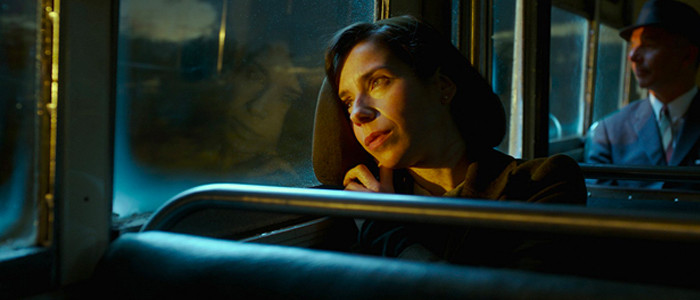
The Dance Scene in The Shape of Water
Though Guillermo del Toro's 1960s-set romance has the fantastical premise of a woman who falls in love with a fish man, there's still a certain level of reality that's established in the director's gloriously realized The Shape of Water. So it's no surprise that when that established level of reality is shattered with an elaborate dream sequence involving Sally Hawkins' mute protagonist doing a heightened ballroom dance routine with Doug Jones' fish creature, some viewers are taken out of the story. It's a divisive scene, but it's also beautiful one, and I think that divisiveness (even among the /Film staff) is part of the reason it makes the cut for our favorite moments of 2017. It's a big swing from del Toro, and movie lovers are always in need of people who are willing to take chances like that – even if they don't always work for everyone. But for those who did love the scene, it's an extraordinary black and white callback to Old Hollywood filmmaking and an affecting display of love from a woman who imagines communicating her overwhelming feelings in the best way she can fathom. (Ben Pearson)
The Funeral in Logan
No scene made me cry more than saying farewell to Wolverine when he dies at the end of Logan. While I had mentally prepared myself for the death of Wolverine since this was meant to be Hugh Jackman's final turn as the mutant, the swell of emotions that overcame me upon his actual death caught me off guard. From the borrowed eulogy that Laura gives at his freshly dug grave to the second gut punch of her turning the grave's cross into an "X," this scene broke me in every way possible. It was nice to have a superhero blockbuster pull that kind of emotional reaction from me and stream tears down my face. (Ethan Anderton)
The Market Scene in Valerian and the City of a Thousand Planets
Valerian suffers from some hackneyed storytelling and questionable casting, but one thing that you can't dismiss are the film's extraordinary visuals. One of the opening set pieces demonstrates the film's abundance of ideas and its ability to realize them. Valerian (Dane Dehaan) and Laureline (Cara Delevingne) go to a bazaar called Big Market to retrieve a Mül converter. Dehaan wields gloves and glasses that can reach through dimensions. The whole concept is insane but the fact that director Luc Besson is able to convey the events coherently is a miracle. The end result is breathtaking – every frame packed with so much detail that it would take a dozen viewings to fully take it all in. (David Chen)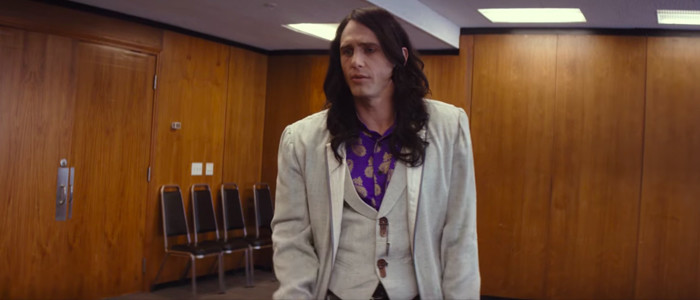
Tommy Wiseau Auditions in The Disaster Artist
There are tons of moments we could pick from The Disaster Artist that would make this list, but Tommy Wiseau's audition scene stands out as one of the film's most heartbreaking and hilarious bits – and pulling off both simultaneously is a difficult feat. While aspiring actor Greg Sestero (a terrific Dave Franco) almost instantly gets an agent because of his model-esque good looks, his less conventional friend Tommy (James Franco) has far more trouble during an audition scene of his own. As a casting director played by the delightful Casey Wilson watches with confusion, Tommy attempts to transform into a typical All-American guy...but despite his brazen confidence, he's hilariously incapable of dropping his eastern European accent. It's laugh out loud funny but it's also kind of sad, a microcosm of the types of juxtapositions the film depicts so well. In another film, that kind of failure might be the thing that crushes the protagonist's dreams, but because of Tommy's drive and determination, it ends up being just another obstacle to be overcome along the way. (Ben Pearson)
The Ménage à Trois in Professor Marston and the Wonder Women
There are actually two dress-up threesomes in Professor Marston and the Wonder Women, an excellent movie that none of you bothered to see, you jerks. The film focuses on William Moulton Marston (Luke Evans), the creator of the lie detector and the character Wonder Woman. Marston and his wife, Elizabeth (Rebecca Hall) find themselves equally drawn to one of their students, Olive (Bella Heathcote). Since the film begins in the 1920s, a polyamorous relationship is heavily frowned upon by "normal" society, which leads the Marstons and Olive to fight their urges and resist temptation.But after a confrontational moment, where Olive confesses that she loves Elizabeth, the three finally give in and make love on the stage in an abandoned theater class, which enables them to put on the costumes that are hidden backstage. It's all set to Nina Simone belting out "Feeling Good", and it's sexy, funny and charming.Later in the film, the Marstons and Olive move into a house together, and continue their dress-up role-playing sex – with less-than-happy results. A neighbor just happens to wander into the house (note: this moment seems a bit forced; why would a neighbor just walk into someone's house?), and catches the three in the act. This leads to the crumbling of the relationship: the "real" world has forced itself into their lives and shined its high-and-mighty spotlight on them. (Chris Evangelista)
Michael Fassbender and Michael Fassbender Play the Flute in Alien: Covenant
As you watch Alien: Covenant, it becomes increasingly clear that director Ridley Scott is less interested in the alien and more interested in using the alien to explore the questions that concern him more. For fans hoping for gnarly xenomorph action, that's a bummer. For people totally on board with one of cinema's most accomplished filmmakers leaping headfirst into science fiction nihilism, it's a deranged joy. The diseased heart of Covenant is David and Walter, the two androids played by Michael Fassbender. The former is a mad scientist and a tinkerer, an artificial being with no love for human beings and a desire to create something new. The latter is a blank slate, programmed to serve humans. They ultimately clash and David's creations ultimately kickstart all kinds of brutal mayhem, but before that, the two androids play the flute. It's a deliciously homoerotic scene, as David trains his mirror image to try something creative, to break out of what humanity expects of him. And of course it involves a phallic object. It's Scott at his cheeky best – the only character David cares for in the slightest is the one that looks like him. He loves himself enough to give this dullard droid a chance at self-improvement. (Jacob Hall)
"It's Been an Unbreakable Sequel All Along!" in Split
One of 2017's biggest "holy shit" moments was the ending of Split, in which it's revealed that everything you've just seen has taken place in the same universe as M. Night Shyamalan's 2001 superhero drama Unbreakable. As a news anchor relays conflicting reports about the fate of James McAvoy's character and refers to him as "The Horde," a diner patron recalls aloud that the scenario reminds her of a man who was jailed 15 years prior who also had a "funny name." The camera pushes in to reveal Unbreakable hero David Dunn (Bruce Willis) seated next to her as he says the name of his nemesis played by Samuel L. Jackson: "Mr. Glass." McAvoy's stellar performance alone would have been enough to justify the existence of this movie, but secretly placing it in the context of a larger cinematic universe was a shocking, thrilling move that also recontextualizes the entire movie; it's all a bit easier to swallow when you realize this is a world in which superheroes and super villains can exist. Bring on Glass in 2019. (Ben Pearson)
The “Nice Guy” Reveals His True Colors in Colossal
Throughout Colossal, we get the impression that Jason Sudeikis is just one of those nice guys who ended up stuck in the town that he grew up in. But the actor gets a chance to show a completely different side of his work when we discover that this isn't a nice dude at all. He's a manipulative, controlling, abusive alcoholic, and he doesn't hold back from letting Anne Hathaway have it. This thematic turn gives the strange sci-fi concept at the center of the movie even more weight when it comes to a head and these two monsters (both metaphorical and literal) are going to have a hell of a fight. (Ethan Anderton)
The Gala Dinner in The Square
Most people will do almost anything they can to avoid social discomfort. This aversion to having one's complacency disrupted tends to jive poorly with progressive ideas, and Ruben Östlund's The Square takes aim at this tension. In the art world, equality and compassion are prized, but to what extent are people willing to act out their beliefs in real life? These concepts come to a head in a riveting set piece at a gala dinner. Thrillingly acted, brilliantly staged, and uncomfortably long, the gala dinner features an artist (played by Terry Notary) terrorizing dinner guests by behaving like an ape. While art patrons are amused at first, the amusement quickly changes to discomfort and then outright terror, as Notary's character refuses to drop the act. Only when a female patron is in extreme distress do the rest of the patrons intervene, casting aside their inhibitions to subdue the threat. It's a vivid showcase of the limits of discomfort to which the elite will allow themselves to be subjected, and a surprisingly intense stress test for the social contract. (David Chen)
The Final Monologue in Call Me By Your Name
I had heard about Michael Stuhlbarg's monologue at the end of Call Me By Your Name, and how powerful it was, before seeing the film. Yet even with this in mind, the moment still blew me completely away. Stuhlbarg is a constant presence in the film, although usually in the background. He plays the father of Elio (Timothée Chalamet), who has just spent the summer in a complicated relationship with Stuhlbarg's assistant Oliver (Armie Hammer).After Oliver heads back to America, Elio is heartsick – a fact that his father clearly picks up on. More than that, it's clear his father has a better idea of what was going on between Oliver and his son than what the film had previously let on. "You had a beautiful friendship," Stuhlbarg says. "Maybe more than a friendship. And I envy you." This begins an achingly beautiful, devastatingly empathetic speech from Stuhlbarg. It's a moment of acceptance, and honesty, that many people can only hope to achieve one day, and Stuhlbarg delivers it in such a calm, honest fashion that it simply takes your breath away."I'm grateful that people have expressed what they're going through and what it meant to them. To be on the receiving end of it is breathtaking and humbling. Absolutely humbling," the actor told The Daily Beast about the scene."I was warned about the speech!" Stuhlbarg told Interview magazine. "My agent called and said, 'There's a very beautiful thing to say at the end of this screenplay, but read the whole thing.' And it had affected me as it seemed to affect her." The actor goes on:
"In some ways, it's hard to remember what my first reaction was. I just knew it was an extraordinary opportunity. My first thought was trying to absorb who this man was that said all of these things, where he came from, what his past life was, what his passions were, what his love was, what kind of father he was, where it was coming from. I took my time, but certainly if you're given something like that to say, you think, 'How am I going to do this?!'"
Stuhlbarg is one of the best actors working right now, and his delivery of this speech may very well be the best moment of his career to to date. (Chris Evangelista)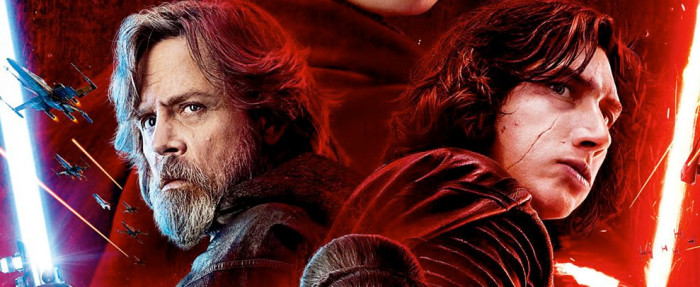
Luke Skywalker’s Last Stand in Star Wars: The Last Jedi
Fans have been waiting to see the full return of Luke Skywalker ever since it took an entire movie to find him back in 2015, and (for the most part) they weren't disappointed with the display of power he puts on in the third act of Star Wars: The Last Jedi. After a couple tender moments spent with his sister Leia and a cheeky wink to C-3PO, Luke is ready for his last stand. His survival of an insane amount of laser blasts from the First Order's AT-M6 walkers already provides a perfect applause-worthy moment, especially after he responds by merely brushing dirt off his shoulder. But when it's revealed that Luke isn't physically there and has been Force-projecting himself in order to create the legend that everyone hoped he would be, it makes you want to stand up and cheer. (Ethan Anderton)
The Sex Scene in Blade Runner 2049
Blade Runner 2049 asks a lot of big questions and then leaves the answers up for interpretation. But one of them lingers on the edge of my mind more than any other: is the relationship between Replicant Blade Runner Agent K (Ryan Gosling) and his holographic girlfriend Joi (Ana de Armas) real? After all, she has been programmed to serve him, to be the perfect companion. It's her duty to stick by his side and he's lonely enough to buy a show like that hook, line, and sinker. And yet, it could be argued that Joi goes above and beyond the call of duty, hiring a sex worker named Mariette (Mackenzie Davis) to act as her stand-in and allow them to be physically intimate for the first time.
In a scene that boggles the mind with its sensuality and inventiveness, the holographic Joi locks herself over Mariette, allowing the second woman to look like K's lover. It's imperfect (parts of Mariette frequently "break through" the holographic visage painted on top of her), but it's beautiful and spellbinding, a grand gesture from an A.I. to the artificial person she loves. It's possible to read this as Joi simply acting on her programming, finding a new way to please K. But I like to think that this scene is an extension of Blade Runner 2049's grander themes – even artificial beings deserve love and affection and freedom. Plus, Joi promptly kicking Mariette out of her apartment when the evening has concluded suggests an all-too-human jealously. (Jacob Hall)
Kay Graham’s Face When She Decides to Run the Pentagon Papers in The Post
For me, one of the most impressive things about Steven Spielberg's long career is the how, in every Spielberg movie, you can always feel that he's intensely dialed in to his characters and their emotions. Even in his biggest blockbusters, his movies retain a humanity that sets them apart from the work of his contemporaries. In a comparatively small-scale film like The Post, that humanity is front and center as we follow The Washington Post publisher Kay Graham (Meryl Streep) through a particularly difficult period of decision-making that has enormous consequences. The entire film builds to a yes or no decision from Graham about whether or not to publish the Pentagon Papers in her newspaper, and Spielberg's close-up on Streep's face becomes a spellbinding source of suspense as we watch her weigh the possibilities and consequences before ultimately giving the go-ahead. That the scene takes place inside her character's dining room while she's wearing a kaftan has been a source of amusement for Film Twitter, but there's real power in Spielberg's filmmaking in that moment – enough to make us briefly forget that we already know what her answer will be and get caught up in just how important that decision was to history (and her story). (Ben Pearson)
The Prison Escape in War For the Planet of the Apes
After being trapped in a prison and forced to do slave labor for Woody Harrelson's evil Colonel, the apes' prison escape sequence is a much-needed breath of fresh air in a franchise that isn't afraid to get bleak. Even this scene itself is bittersweet: there's an emotional reunion of the parents with their ape offspring followed by a humorous sight of the creatures shimmying across wires above human soldiers' heads, and everything seems to be going according to plan...until a war breaks out between humans, and the apes are caught in the crossfire just outside the gates. It's a wrenching scene, all crosscut with Caesar's morally twisted final stand against the Colonel, and culminates with Red (an ape that sided with the humans in the battle) seeing his former friends and loved ones gunned down, so he sacrifices himself to save Caesar. The avalanche that follows is admittedly a little too easy of an ending, but everything before that is superb blockbuster filmmaking. (Ben Pearson)
Batman Crashes the Justice League Party in The LEGO Batman Movie
The best part of the Batman Lego Movie is not its fearlessness to lean into meta pop culture jokes, but its loyalty to the essence of Batman and his found family. The result: a dorky, delusional Batman (played with gusto by Will Arnett) who chooses to believe that he is a grim loner — only to have that illusion hilariously shattered every other second. The Justice League party that Batman accidentally crashes at Superman's Fortress of Solitude is a prime example of this. The two of them banter about fighting each other ("I would crush you"), but it's all a stalling technique so that Batman won't find out he wasn't invited to the party. The emotional weight of this moment is quickly glossed over — this is a kid's movie after all — but it still stands as a one of the all-time great comedic moments of the year. Batman needs to be taken down a peg or two, even if it's to take a group picture of everyone else but him. (Hoai-Tran Bui)
Maureen Texts in Personal Shopper
There's nothing cinematic about sending a text. As cell phones and texting became a part of everyday life, films and TV have struggled to find ways to incorporate texting into their narratives, with limited results. The BBC show Sherlock became fond of having the pop-up text bubbles appear in the air above character's heads, a decision that always seems more distracting than innovative. Olivier Assayas' Personal Shopper has cracked the problem: all you need to make texting in movies is work is cast Kristen Stewart.Stewart, with her fidgety, nail-biting performance, spends approximately 98% of Personal Shopper glued to her phone, texting with either a ghost or a murderer, depending on what mood the movie is currently in. On paper, this should not work, yet the way Assayas brings his camera in tight on the screen of Stewart's iPhone, and the way he then cuts to close-ups of Stewart's face, her brow furrowed, strands of hair hanging down in her eyes, makes all of this incredibly exciting. "R U alive or dead?" Stewart writes to her mystery texter, and instead of guffawing at the sight of it all, we're heavily engrossed. It's remarkable.Note: the only drawback here is that Stewart's character keeps the clicking sound effects turned on as she types. Girl, hit up the settings and turn that shit off. (Chris Evangelista)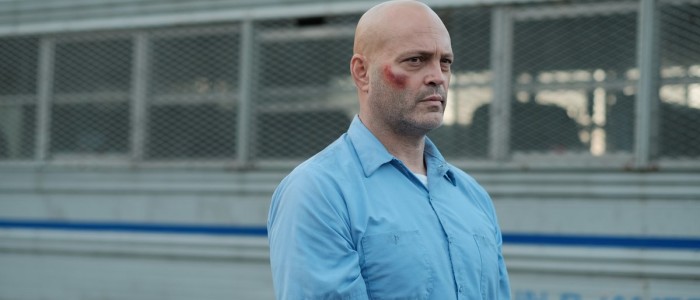
Bradley Thomas Destroys a Guy's Face in Brawl in Cell Block 99
I don't think Brawl in Cell Block 99 is a good movie, but it would be foolish to deny that it features one of the most memorable scenes to arrive in 2017. Late in the film, Vince Vaughn's bruising prison inmate has found himself in the titular location, a hellish place reserved for the worst of the worst. He doesn't belong here, but he's on a mission of revenge – he has several men to kill. And kill them he does! But one guy gets it worse than the others. After putting him on the ground, Bradley jams his heel into the back of the man's head and drags it across the stone floor, decimating his skull and leaving his face a red mass of ruin. It's the kind of scene that will become the stuff of gory legend when it eventually hits YouTube. Hell, it may be the single most violent act ever depicted in any movie. (Jacob Hall)
The Stand-Off in Wind River
With its gorgeous cinematography of the snow-covered plains of Utah and Wyoming, Taylor Sheridan's Wind River spends most of its runtime conveying the beauty and desolation of the West. At the Wind River reservation, only six police officers support an area the size of Rhode Island and other social services are challenging to obtain. It's in this environment that FBI agent Jane Banner (played by Elizabeth Olsen) goes looking for clues to explain a local woman's tragic death. As she descends on a drill site with local police, flanked by security officers, the tension builds to a breaking point. Misunderstanding gives way to defensiveness and further misunderstanding. The tension subsides temporarily, only to erupt again in a massive firefight. It's a standoff for the ages, and one that demonstrates that in this situation, the only law is the man who has the best aim. (David Chen)
Superman Races the Flash in Justice League
In one of the most satisfying moments of an otherwise average superhero movie, we see the Superman that fans have been dying to see share a playful moment with The Flash by trying to determine which of them is faster. The end of the scene looks like a spread straight from the comics as the two speed off in slow-motion. This is the kind of stuff that should have been part of the DC Extended Universe from the beginning. (Ethan Anderton)
The Door is Open in It Comes at Night
Throughout the haunting It Comes At Night, the red door looms in young Travis' (Kelvin Harrison Jr.) nightmares, and in our imaginations. It's the sole barrier between the two families residing in Paul (Joel Edgerton) and Sarah's (Carmen Ejogo) isolated cabin and the outside world, ravaged by some unknown virus. And it's the ultimate barrier between reality and dream — a line that becomes progressively blurred on the night that Travis discovers the door is open. It's a subtle scare, as are all the scares in this Trey Edward Schults' film, driven by paranoia and a creeping ambiguity. Travis had woken one night after a particularly ominous nightmare about his grandfather, only to find little Andrew sleeping in his grandfather's bedroom. After returning Andrew to his parents' room, he passes the red door and notices that it stands ajar. He slowly approaches it and finds their bleeding and sick dog on the floor, and terrified, he awakens the rest of the house. This is the tipping point for the film, after which the distrust and paranoia between the two families reaches a fatal boiling point.
So who opened the door? It's left intentionally ambiguous, with Schults cryptically telling Slate that there was an intentional "nightmare grammar" surrounding Travis seeing the open door. But, he continued, "There's any number of possibilities. But the movie is about the fear of the unknown. If you just look throughout the whole, so much of it is rooted in that, from 'Who we can trust?' to 'What's actually going on?' to 'What even actually happens?'" What happens is up to the viewer's interpretation, but the entire, nightmarish sequence is a crowning achievement in one of the best cerebral horror films of 2017. (Hoai-Tran Bui)
“No, No, No” in Get Out
If Chris (Daniel Kaluuya) getting tossed into the Sunken Place wasn't a shocking enough moment, there's even creepier tension that comes in this scene when the Armitage family maid appears to be a bit flummoxed in her interaction with the visitor. The performance here by Betty Gabriel is so unnerving as she appears to be holding back the Armitage's grandmother from taking back her body from inside her mind. A single tear rolls down her face as the most forced smile imaginable is put on display. It's one of the most unsettling moments of the movie, and it's perfectly executed. (Ethan Anderton)
John Denver and a Crushed Skull in Free Fire
The music of John Denver was inexplicably prominent in 2017 films (including Alien: Covenant and Kingsman: The Golden Circle), but nothing could top Free Fire. Late in this feature-length shootout, after most of the cast is dead and everyone else is pretty much dying, "Annie's Song" kicks in on the van radio as Stevo (Sam Riley) and Harry (Jack Reynor) battle to the death in the front seat, using their last remaining bullets before resorting to their teeth. And then Stevo falls from the van and Harry sloooooowly turns it around, crushing Stevo's head beneath his wheels as John Denver's soft voice echoes through the decimated warehouse. (Jacob Hall)
The Heist in Okja
It's not a heist in the traditional sense of the word, but more a series of hilarious blunders, sweet heartwarming moments, and surprising feats of strength from a 13-year-old girl. But boy, does it move. Mija's (Ahn Seo-hyun) spirited attempt to rescue Okja from the clutches of the Mirando Corporation spans nearly the entire length of Seoul before she is joined by the quirky cabal of Animal Liberation Front protestors, intent on using Okja for their own means. Their sabotage of the truck carrying Okja is where the heist "begins," but it only succeeds thanks to the overwhelming apathy of the truck driver and the incompetent Mirando workers.
As tense and action-packed as the rescue scene is, following Okja at one point rampaging through a mall, it never lets up on its tongue-in-cheek tone (example: the fleeing girl who takes a quick selfie with a panicked Okja in the mall). The chaotic sequence is grounded by Mija's prevailing love and loyalty to Okja, as well as Paul Dano's eerily calm demeanor as Jay, the leader of the ALF. But Mija and Jay's wary alliance all ends in betrayal thanks to the efforts of Steven Yeun's smarmy K, who mistranslates Jay's message to Mija so that the ALF can move forward with their plan to expose Mirando. It's a heartbreaking ending to a previously triumphant and almost light-hearted action scene. (Hoai-Tran Bui)
The Search for the Bottle in Good Time
Good Time is a 99-minute panic attack, a ruthless and relentless thriller about ill-fated and ill-equipped criminals that drains the oxygen from your lungs as you witness one poor decision after another. Late in the film, after the mistakes have begun piling up so high that the slightest rumble will cause everything to come crashing down, Constantine "Connie" Nikas (an astonishing Robert Pattinson) decides that the only way out of his predicament is to obtain a bottle filled with LSD stashed in a carnival funhouse. By this point, Connie is neck deep in bad choices and it's borderline impossible to remember how he even got to this point...which makes his nightmarish trek through the attraction all the more insane, especially when a security guard and a few police officers get involved. (Jacob Hall)
The Losers’ Club Says Goodbye in It
For all of It's loud, clown-based horror, the moments that truly stand out in Andy Muschietti's Stephen King adaptation are the quiet, surprisingly sweet moments. One of the key ingredients to making the film work is how much time Muschietti devotes to developing the Losers' Club, a group of seven social misfits who come together to save their cursed hometown from evil. It helps that the kids playing the Losers – Jaeden Lieberher, Jeremy Ray Taylor, Sophia Lillis, Finn Wolfhard, Wyatt Oleff, Chosen Jacobs, Jack Dylan Grazer – are incredibly likable, and have real chemistry with each other. As It draws to a close, and evil is (momentarily) defeated, the seven friends gather one last time as the summer is coming to an end. They cut their palms and clasp hands in a ritualistic circle, binding themselves to each other for all time, come what may.And then one by one, they go their separate ways. Wyatt Oleff's character Stan is the first to go, and anyone who has read King's book, and knows what happens to Stan later, will find a poignancy in this detail. Soon, everyone is gone, except Jaeden Lieberher's Bill, the default leader of the Losers, and Sophia Lillis' Bev, the lone girl of the group. "Just so you know," Bev says to Bill, "I never felt like I was a loser when I was with all of you." This is the part of the movie where I begin to slowly weep. In this one simple, effective moment, Muschietti's film has captured the true power of King's novel. It's not the horror; it's not the jump-scares. It's the power of a group of self-proclaimed losers coming together and finding each other; of realizing they're not as alone in the world as they once thought they were. Yes, evil will rise again, but for this one brief, fleeting moment, that doesn't matter. (Chris Evangelista)
Peter Parker Meets the Parents in Spider-Man: Homecoming
There hasn't been a twist this shocking in the entirety of the Marvel Cinematic Universe and the fact that it's pulled off so easily and impressively only makes it that much more satisfying. For the entire film, we've seen the back and forth between Spider-Man and the Adrian Toomes, aka Vulture (Michael Keaton), the latter only trying to maintain his business (albeit an illegal one) so he can provide for his family. Meanwhile, Spider-Man has just been trying to do the right thing by stopping him from putting dangerous weapons into the hands of thieves in New York City. But we've never put together the fact that the family Toomes is providing for includes none other than Peter Parker's date to the homecoming dance, Liz. That makes the moment when Peter meets Adrian at the door of Liz's house a truly jaw-dropping moment that elicited audible gasps and whispers both times I saw the movie in theaters.
The drive to the homecoming dance that follows has the perfect amount of tension as Peter struggles to figure out how to deal with this revelation and Adrian slowly becomes aware that his daughter's date is none other than the pesky wallcrawler who has been messing up his business. Both Michael Keaton and Tom Holland play off each other fantastically, and you couldn't ask for a more perfect scene in the movie. (Ethan Anderton)
The Living Room Meeting in The Killing of a Sacred Deer
My longstanding belief about conspiracy theories is that they're popular because deep down, humans prefer to believe there's a higher power at work. It's terrifying to contemplate the possibility that every occurrence is completely random. Much more reassuring to think that someone is pulling all the strings, even if that someone is malevolent. The Killing of a Sacred Deer turns this notion on its head. Here, surgeon Steve Murphy (Colin Farrell) becomes increasingly certain that teenager Martin (played chillingly by Barry Keoghan) exerts an other-worldly power over his family, causing them to become increasingly sick. The only thing that will cause it to stop is if Murphy takes one of his family member's lives – retribution for Murphy's own errant hands taking the life of Martin's father in a botched surgery. After agonizing over how to proceed, Farrell decides that introducing randomness into the equation is the only solution. He ties up his family in the living room and spins around randomly, firing a rifle until one of them is dead. It's a brutal, heartbreaking scene with an unspeakable outcome, demonstrating that sometimes, chance is only outcome we can live with. (David Chen)
Thelma's Dad is Engulfed in Flames in Thelma
Self-actualization becomes violent in Thelma. The antithesis to another repressed powerful teenage girl film, Carrie, Thelma posits the theory that you can build your own world — you just might have to kill your parents to do it. Toward the end of the Norwegian supernatural thriller, the titular Thelma (Eili Harboe) has taken refuge with her parents after she lost control of her powers and accidentally erased the girl that she loved. But her overprotective parents only feed the resentment in her as she slowly becomes aware of the drugs they give her and the memories they hid from her. Finally, the emotional battle between Thelma and her parents culminate in her telepathically setting her father on fire as sits alone in his lakeside boat — the spontaneous flames swallowing him up even after he attempts to jump into the lake. It's a violent moment of self-discovery for Thelma, who counters the cruelty against her father with a gesture of forgiveness towards her distressed, disabled mother, healing her paralyzed legs with a touch.
Embracing herself for who she is, she leaves her horrified parents, essentially an all-powerful god. It's a cunning metaphor for coming out — as soon as Thelma accepts her true self, only then can she control her own world. (Hoai-Tran Bui)
Harlan Eustice Loses a Hand in Molly’s Game
For one brief yet wonderful moment, Aaron Sorkin's Molly's Game stops being about Jessica Chastain's Molly Bloom, and suddenly turns into a movie about a character named Harlan Eustice, played by character actor extraordinaire Bill Camp. Harlan is a master poker player – a guy who tends to win constantly. Then one night, while playing at one of Molly Bloom's high-stakes poker games, Harlan comes up against Brad (Brian d'Arcy James), an abysmal poker player who just likes to play so he can hang out with the guys.Harlan doesn't know Brad is a terrible player, however, and mistakes Brad's ineptitude for master bluffing. As a result, Harlan folds, only to discover Brad didn't have a winning hand at all. This sends Harlan off the deep end, and he begins a marathon poker session that ends up putting him deeper and deeper into the hole. Sorkin does a wonderful job setting all of this up: we see Harlan's confidence, and then we see it crumble before our very eyes, as Camp's performance becomes more and more unhinged and desperate. This is, all in all, a brief moment in a long film, yet through Sorkin's crackling writing, and Camp's flop-sweat drenched performance, it becomes one of the most memorable scenes in the film. (Chris Evangelista)
Thor and the Hulk Reunite in Thor Ragnarok
Thor: Ragnarok was one of the most enjoyable superhero movies of 2017, and one of the film's best moments was a centerpiece of its earliest trailers. As a captured Thor (the very funny Chris Hemsworth) is led out into a massive gladiatorial arena on Sakaar under the watchful eye of The Grandmaster (Jeff Goldblum, delivering the Jeff Goldblum-iest performance imaginable), The Incredible Hulk (Mark Ruffalo) bursts through the gates on the other side and presents himself as Thor's opposition. While the cheering fans and the Grandmaster expect a shocked or horrified reaction from Thor, the Asgardian hero instead bellows his excitement, and as the crowd falls silent, he looks up and explains that the Hulk is "a friend from work." Hemsworth's childlike delivery deflates the supposed import of the moment (a tactic used with great success by director Taika Waititi time and time again in this movie), and even though we'd seen it dozens of times in trailers already, it's a testament to the way all of the elements came together that the line works even better in context. (Ben Pearson)
The Ending of The Florida Project
Almost all of Sean Baker's remarkable The Florida Project strives for realism. The film presents a warts-and-all look at poverty, never glossing things up and never sentimentalizing either. The film is set mostly in a run-down Florida motel near Disney, and focuses on six-year-old Moonee (Brooklynn Prince) as she gets in one adventure to the next.The film's powerful, emotional conclusion finds Moonee about to be taken away from her mother (Bria Vinaite) to foster parents, a move the young girl clearly doesn't understand. The tension continues to mount, and Baker does an incredible job escalating the scene from calm and controlled to near hysterics. Then The Florida Project decides to break your heart. Moonee runs away to find her best friend, Jancey (Valeria Cotto), and when she does, Baker's camera lingers on Moonee's face as she struggles to find words she doesn't fully grasp. If you're not sobbing uncontrollably at this point, I'm pretty sure you're a robot or a sociopath. Things seem hopeless and bleak, and then something magical happens: Jancey grabs Moonee's hand, and they take off. The speed of the film changes, the music picks up, and the children run until they're right in the heart of the Magic Kingdom. It's a fairytale ending; a fleeting, lovely moment of peace to relieve a tension filled scenario.Baker shot the scene undercover, using an iPhone 6s. "It has what's called a rolling shutter, and it gave it this hyperactivity and a very different, jarring feel, and we liked that," the director told THR. "We could have shot it on a 5s and made it more smooth, but we actually wanted to the audience to know that we were jumping from 35mm to another medium."As wonderful as this ending is, several people have taken issue with it (several members of the /Film team love the movie but are divided over the ending). Frankly, I'm baffled by this. To each their own, of course, but the ending is the most essential part of the entire film; it's the moment that solidified The Florida Project as my number one movie of 2017. For his part, Baker too was surprised at the reaction to the ending. "It's left up to interpretation but it's not supposed to be literal, it's supposed to be a moment in which we're putting the audience in the headspace of a child," he told THR. "And in the end, with this inevitable drama, this is me saying to the audience, 'If you want a happy ending, you're gonna have to go to that headspace of a kid because, here, that's the only way to achieve it.'" (Chris Evangelista)

